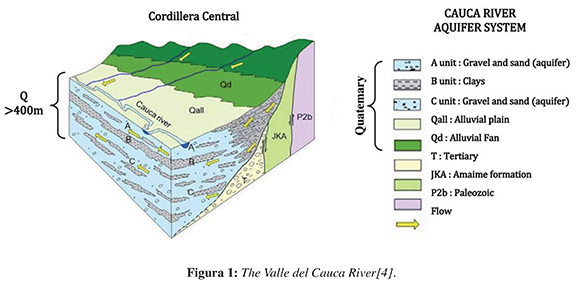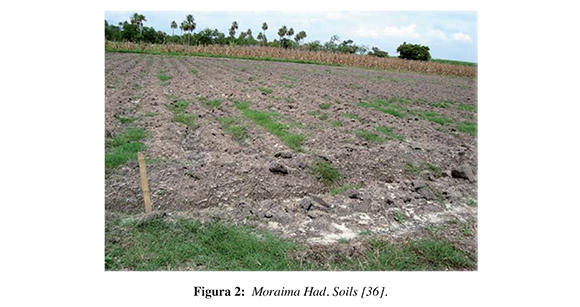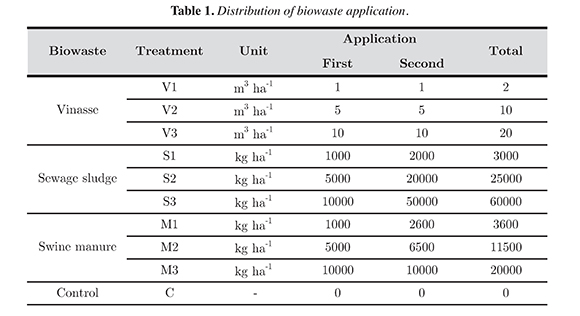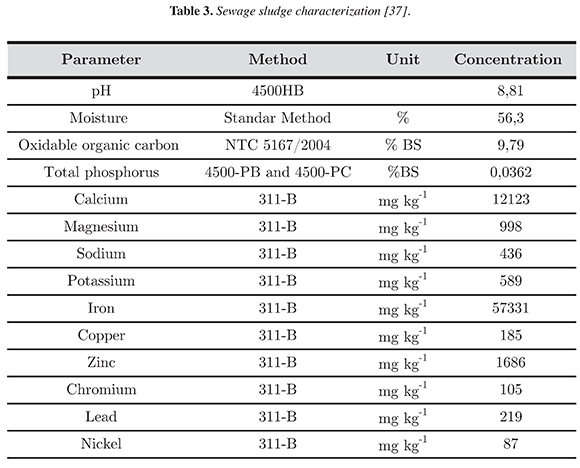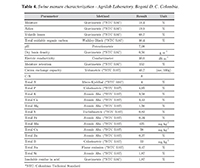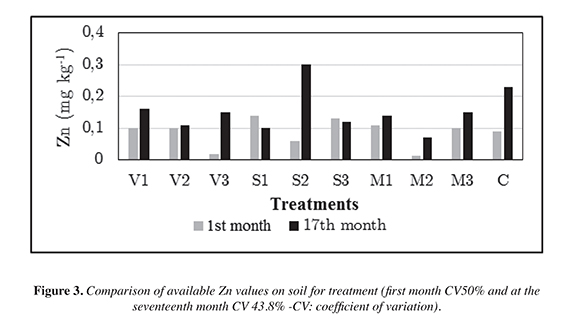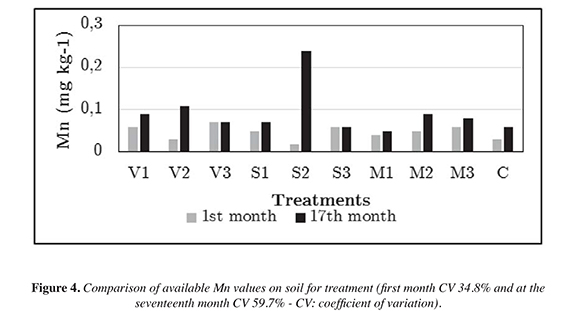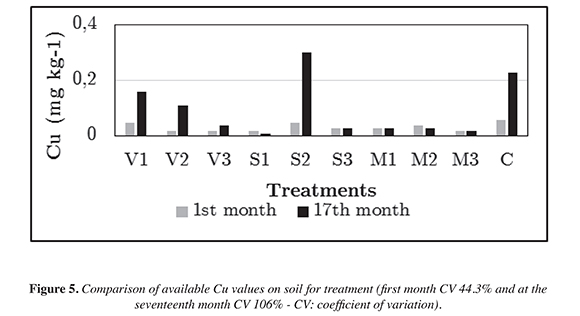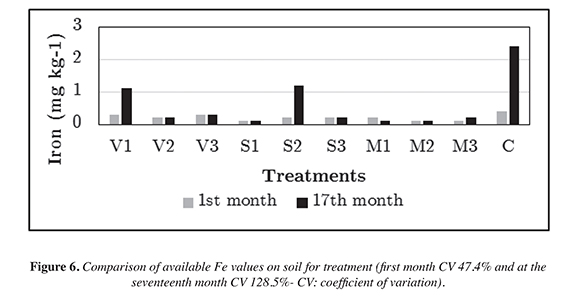Services on Demand
Journal
Article
Indicators
-
 Cited by SciELO
Cited by SciELO -
 Access statistics
Access statistics
Related links
-
 Cited by Google
Cited by Google -
 Similars in
SciELO
Similars in
SciELO -
 Similars in Google
Similars in Google
Share
Revista de Ciencias
Print version ISSN 0121-1935
rev. cienc. vol.20 no.1 Cali Jan./June 2016
Evaluation of Heavy Metal Content on a Sodic Soil Treated with Bio-waste
Mauricio A. Gutiérrez C.
Grupo de Investigación en Ciencias Ambientales y de la Tierra ILAMA, Departamento de Física. Universidad del Valle, Cali - Colombia
E-mail: mauricio.gutierrez@correounivalle.edu.co
Orlando Zúñiga E.
Grupo de Investigación en Ciencias Ambientales y de la Tierra ILAMA, Departamento de Física. Universidad del Valle, Cali - Colombia
E-mail: orlando.zuniga@correounivalle.edu.co
Jhony A. Benavides B.
Grupo de Investigación en Ciencias Ambientales y de la Tierra ILAMA, Departamento de Física. Universidad del Valle, Cali - Colombia
E-mail: jhony.benavides@correounivalle.edu.co
Daniel I. Ospina Salazar
Facultad de Ciencias Agrarias, Universidad Nacional Sede Palmira, Palmira - Colombia
E-mail: diospinas@unal.edu.co
Paul G. López Posso
Grupo de Investigación en Ciencias Ambientales y de la Tierra ILAMA, Departamento de Física. Universidad del Valle, Cali - Colombia
E-mail: memolopez@gmail.com
Reccived: December 7, 2015
Accepted: June 9, 2016
Abstract
The use of bio-wastes in agriculture contributes to the conservation of natural resources by recycling carbon and mineral elements. This investigation evaluated the variation of the content of heavy metals in soils affected by sodicity, on which alternating doses of bio-wastes were applied: vinasse, composted swine manure and sewage sludge from a wastewater treatment plant. Ten treatments with three doses were implemented for each bio-waste treatment in addition to the control treatment. During the investigation, two applications of bio-waste were performed with a temporal spacing of two months and three samples were taken: the f rst one corresponding to the initial condition of the area without the application of bio-wastes, and the remaining two samples were taken on the f rst and seventeenth month respectively after the application of bio-wastes. The results indicated a low intake of heavy metals on the soil in the three evaluations that were carried out. However, the use of these residues in agriculture requires specif c recommendations for each agro-climatic condition to prevent environmental damage.
Keywords: Vinasse, sewage sludge, soil remediation, composted swine manure, heavy metal content.
1. Introduction
It is known that several organic materials, such as farmyard manures, agro-industrial by-products and composts can be used as amendments to enhance and sustain the overall soil fertility (Diacono & Montemurro, 2010; Montemurro et al., 2010). The same amendments could likely be considered for soil remediation in the salt-affected areas due to their high organic matter content. In fact, organic matter has several benef cial effects on agricultural f elds, such as the slow release of nutrients, soil structure improvement, and the protection of soils against erosion (Roy et al., 2006). The high cost of fertilizers and concerns about environmental protection have been great incentives to study the recycling of the large quantities of organic residues produced as by-products of diverse industries. Therefore, the need for more environmentally sound methods for the treatment and utilization of bio-wastes has become imperative and in turn, the signif cance of establishing an integrated environment-bio-waste system cannot be underestimated.
1.1 Vinasse
In 2006, biofuel production (ethanol) from sugar cane distillation started in fve sugar mill factories (ingenios) located in Valle del Cauca (Colombia). Nowadays, around 11.000 ton year-1 of liquid vinasse (between 6 - 15 m3 per ha) are applied as fertilizer (fertilization) for sugar cane to cover 42000 ha where the valley-aquifer outcrops; vinasse application will cover more than 200.000 ha in the near future (Ortegón et al., 2016).
In 2001, through the National 693 Act of September 19th, 2001, the enhanced production and use of sugar cane alcohol distillation (ethanol) was incorporated into the legal framework of Colombia. One of the principal objectives of the National Act was to provide the legal provision for implementing a more effcient environment-friendly use of motor engine fuel by substituting bio-fuel for a certain amount of petrol-derived substances (around 10%) to reduce atmospheric pollution (Ortegón et al., 2016). Vinasse (stillage) is a residual subproduct of the ethanol industrial process, currently used as a solid/liquid fertilizer and a soil conditioner in sugar cane felds. In general, each liter of ethanol generates between 1 and 14 liters of vinasse (Corporación Autónoma del Valle del Cauca CVC, 2012a).
The legal framework includes no specifc measures for implementing agricultural practices against the pollution of water resources or soil from vinasse. However, specifc regulations have been developed for Valle del Cauca by the Corporación Autónoma Regional del Valle del Cauca-CVC local administration (Corporación Autónoma del Valle del Cauca CVC, 2012b).
Large-scale vinasse applications are an effective economic alternative for sugar cane irrigation and fertilization given their high levels of potassium, calcium and organic matter in the chemical composition, as well as moderate amounts of nitrogen and other nutrients (Pradoet al., 2001).
A report from Brazil (Ramalho & Sobrinho, 2001) relates studies on the effects of vinasse (300 m3 ha-1) on properties of various soils, including weakly humid Gley and Cambisol soils, conducted over 10 years. The authors concluded that the amounts of heavy metals were not changed and there was little risk of soil contamination with these elements.
Results from lysimeter studies have indicated that vinasse does not negatively affect soil pH and salinity, and it slightly increases soil organic carbon and exchangeable K+ in Mauritius soils (Soobadar & Ng Kee Kwong, 2012).
A drop in soil bulk density and increased porosity (Jianget al., 2012)after a three year application in an experimental sugar feld location of Guanxi (PR China) have been observed, while negative effects on soil permeability through vinasse application from processing beet have been reported by (Tejadaet al., 2006).
It is obvious that there is no consensus about the polluting capacity of vinasse. The two main lines of thought indicate, on one side, deleterious effects on ground and surface waters while the other side claims that rational use of the residue does not result in environmental risk. However, it should be emphasized that depending on the amount of vinasse applied it might act as a pollutant or a benefcial soil conditioner. In this context, a review article (Silva et al., 2007) concludes that a consensus among authors is that the appropriate application of vinasse must consider the soil chemical and physical characteristics, besides aspects such as the history of residue application, the intensity of cultivation in the agricultural area, and the proximity of water springs.
Characteristics of vinasse that contribute to pollution are high CRO (chemical requirements for oxygen) and BRO (biological requirements for oxygen) values, an acidic pH, elevated temperatures during production, and the consequent corrosive power (Laime et al., 2011).
Continuous application of high volumes of vinasse leads to increased soil nitrogen and potassium, the main chemical components of this residue (Lyra et al., 2003; Brito et al., 2007).
1.2 Sewage Sludge
Sewage sludge is the insoluble residue from wastewater treatment after either aerobic or anaerobic digestion processes. Sludge comprises resistant compounds (65% organic matter), nitrogen (3%), phosphorus (2% P2O5), other macronutrients (0.5% K2O, 5% CaO, 1.5 % MgO) a wide range of macronutrients and nonessential trace elements, organic micro-pollutants, microorganisms and eggs of parasitic organisms. The substantial nitrogen and phosphorus concentration in sludge render is a useful fertilizer material, and its organic constituents give it benefcial soil conditioning properties (Hussein et al., 2010).
The application of sewage sludge in agricultural purposes is generally considered the best alternative for sludge management because it provides the recycling possibility of plant nutrients which provide organic matter to the soil and causes to improve its aggregate stability, porosity and infltration rate of water (Torri & Lavado, 2008). However, due to higher concentrations of toxic metals and pathogenic microorganisms the use of sludge to agricultural land is a big concern. Recent studies illustrated that the extensive addition of sludge to agricultural soils causes accumulation of trace metals which are non biodegradable and tends to build up in soils, waters and crop plants or are transferred to humans through contaminated food (Zaier et al. 2010).
Sewage sludge contains the components of agricultural value e.g., organic matter, nutrients such as nitrogen, phosphorus, potassium, and lower concentrations of calcium, sulphur and magnesium, which make the sludge interesting as fertilizer, but heavy metals, toxins, viruses, pharmaceuticals and hormones, GMOs and dioxins are also present in it (Groß et al., 2008).
Several authors in the feld of this research have stated that the concentrations of total heavy metals can be reduced by composting sewage sludge with biomass (Puyuelo et al. 2008; Obernberger et al., 2009; Albrecht et al., 2010). Sewage sludge has a low C:N ratio (5-10:1). According to (Puyuelo et al., 2011) the composting process begins when the C:N ratio is 20-30:1 (optimal ratio). Therefore, biodegradable waste, which is rich in carbon (e.g. in biomass residues when the C:N ratio is 40 - 750:1), is mixed to improve the analyzed ratio (Albrechtet al., 2010; Cukjati et al., 2012; Kliopova & Stankeviciute, 2013). In this regard, [26] indicates that there are other positive aspects of this mixing, such as minimization of the moisture content from 70-90% to optimal 50-60% maintaining the optimal oxygen content (15 -20%); if the moisture content is higher than 70%, the anaerobic process begins. Finally, (Kliopova & Makarskiene, 2015) explains that the recommended mixing ratio of sewage sludge and biomass depends on the C:N ratio of bulking agents, for example, when the sawdust and aerobic sludge mixture is of 1:1 proportion. However, in the case of more problematic sludge, such as the anaerobic sludge mixture studied, with higher conductivity and the presence of other toxic and phytotoxic substances, (Banegaset al., 2007) presents a frst approximation for a 1:3 proportion to be recommended because of the dilution effect on harmful parameters. These (studies) have to be re-evaluated under local conditions due to the high variability of the properties of bio-wastes.
1.3 Composted Swine Manure
Composts are considered a valuable product that can be used as a source of soil amendment and organic matter in agricultural land. The application of composted animal manure has increased over the years. This practice improves the quality of the crops and preserves the environment (Benítezet al., 1998; Hoitink, 2000).
Manure application is often credited for improving soil physical properties with benefts such as reduced runoff and erosion, and these effects can persist for several years following manure application (Gilley & Risse, 2000; Wortmann & Walters, 2006).
According to the kind of compost, and the process involved in its preparation, its surface application at the soil may represent an improving in water infltration, but this could represent a higherphosphorus concentration at the soil surface. Much of this phosphorus may be protected from runoff due to the increased formation of water-stable soil aggregates associated with an increase in organic particulates with manure application (Six et al., 2000).
In a study using two feld sites in the Peace River region of Alberta (Assefa, 2000) found that a single application of hog manure on the Gray Luvisolic soils increased the aggregation of the soil at one site.
Manure contains plant functional nutrient metals such as copper, zinc, manganese, iron, and it may contain trace amounts of non-functional elements (Schoenau, 2006). A study in Saskatchewan (Canada) Schoenau, 2006) showed that three to fve years of annual swine and cattle manure applications at low (~100 kg Nha-1) and high (~400 kg Nha-1) rates resulted in only small increases in total and bioavailable copper and zinc in surface soils at three study sites.
The contaminant potential of heavy metal and trace elementsis based on mobility and bioavailability of these elements are linked to factors such as pH, content and clay mineralogy, salinity, redox conditions, cation exchange capacity and organic matter (Galán y Romero, 2008). Heavy metals are characterized by accumulating on the soil surface. So the presence of high concentrations in the upper horizon decreases dramatically in depth (Galán y Romero, 2008).
The aim of this study was to measure the effect of three bio-wastes on the heavy metal and trace element content in a sodium affected soil, under undisturbed conditions of the Valle del Cauca region, Colombia.
2. Methods
2.1 Study Area
The study area is located in the southern part of the Valle del Cauca River basin in Cali, which is an intermountain-savannah plain area, characterized by a smooth surface and with a mean ground surface elevation of 1200 m.a.s.l. The main permanent surface water is the Cauca River. The Valle del Cauca region has a typical tropical climate with an average annual temperature of 24 °C and an annual precipitation of 1400 m3. One important aspect of the precipitation pattern is a tendency for heavy rainfall during short periods of time on an irregular basis due to a tropical climate, as well as the El Niño and La Niña phenomena (Corporación Autónoma del Valle del Cauca CVC, 2012a).
From a geologic standpoint, Valle del Cauca (Figure 1) is a NE-SW trending graben basin of 6900 km2, and is flled with post-orogenic Quaternary materials (silt, gravel, limestone and conglomerates). It forms part of the folded, faulted and thrusted Andes belt (western and central mountain ranges) made up of Mesozoic and Cenozoic of volcanic and sedimentary materials with a maximum height of 4100 m. The sediments from the Quaternary age that fll the intermountain plain are a fuvio-sedimentary formation of the Cauca River (Corporación Autónoma del Valle del Cauca CVC, 2012a).
Figura 1. The Valle del Cauca River[4]
The experimental plots were located in the Valle del Cauca region (Figure 1) and in the sugar cane farming felds (known locally as Haciendas-Had.) named Moraima located in the Cerrito municipality with coordinates: 1076667 E - 902979 N, with a mean ground surface elevation of 973 m.a.s.l. Currently the land is used for the development of pastures for cattle raising due to its low yields in crops such as rice and sugarcane. That limited production capacity is attributed to the high content of salts particularly sodium, which affected productivity.
2.2 Experimental Array
To adapt the study area, mechanized operations were performed; two crossed chisel passes were made, forming the furrow in all the area, 150 furrows were established. Soil preparation was done with the aim of improving conditions for the incorporation of bio-waste. After the mechanizing labor, 10 experimental plots of 490 m2 were defned, each experimental plot had approximately 15 furrows and each of its vertexes was geo-referenced (Figure 2).
Figura 2. Moraima Had. Soils [36]
The experiment array consisted in ten treatments including the control, where the different kind of bio-waste corresponds to the experimental factor considered, while the three doses of the bio-waste applied on the soil correspond to the treatment levels. Two applications of bio-waste were made within two months of separation in order to give the bio-waste enough time for its incorporation into the soil (Table 1). To assess the impact of the dose of each bio-waste on the soil levels of zinc, manganese, iron and copper were measured in mg kg-1.
Table 1. Distribution of biowaste application
The bio-waste used was: vinasse from Ingenio Providencia (sugar cane processing plant) near El Cerrito municipality, sewage sludge from the wastewater treatment plant (PTAR for its name in Spanish) Cali-Cañaveralejo, and the swine manure came from the composting plant of Had. Moraima.
Vinasses were applied to the soil by using manual pumps in order to ensure a homogeneous spreading on every correspondent plot (Table 2). The used sewage sludge passed through the following processes: material selection, transportation to Had. Moraima, storage, transportation to its correspondent plot, unloading, and distribution using spreading equipment (Table 3). The used swine manure passed fve different processes: selection from the composting pile, packaging, transportation to the plot, unloading and distribution using spreading equipment (Table 4).
Table 2. Vinasse characterization- Data sheet provided by the Ingenio Providencia
Table 3. Sewage sludge characterization [37]
Table 4. Swine manure characterization - Agrilab Laboratory. Bogotá D. C. Colombia
3. Results and Discussion
3.1 Soil Characterization
The objective of the characterization of an area near to Had. Moraima was to select an extension with homogeneous conditions to establish the experimental plot. Eight samples distributed in zigzag covering an area of 32400 m2 were taken and geo-referenced.
Below, it is presented in tables 5 and 6, a summary of the results of the physical, chemical, and biological properties of the soil used.
Table 5. Physical and biological soil properties - Agrilab Laboratory. Bogotá D.C. Colombia
Table 6. Soil chemical properties (frst soil) sampling - Agrilab Laboratory. Bogotá D.C. Colombia
3.2 Heavy Metal
To this group belong elements such as zinc, iron, copper and manganese that are at the same time micronutrients necessary for plant growth, but in large amounts in soil they can be a source of contamination (Quintero, 2004). According to (Méndez-Romero et al., 2003), the normal contents of those elements in the soil are: zinc 1.5-4.0 mg kg-1, cupper 1–3.0 mg kg-1, manganese 5.0-10.0 mg kg-1, and iron 10.0–20.0 mg kg-1.
According to the values established by (Méndez-Romero et al., 2003), data presented in Table 6 indicate low availability of micronutrients in the characterized area, which could be gradually increased with the proper application of bio-waste.
3.2.1 Zinc (Zn)
Figure 3 shows zinc (Zn) contents available in soil by treatment in the frst and seventeenth month, where values oscillated from 0.013 to 0.13 mg kg-1 for the frst month and 0.07 to 0.3 mg kg-1 for the seventeenth month indicating a low Zn content in soil under normal range established corresponding to 1.5-4.0 mg kg-1 according to (Méndez-Romero et al., 2003).
Figure 3. Comparison of available Zn values on soil for treatment (frst month CV50% and at the seventeenth month CV 43.8% -CV: coeffcient of variation)
It is important to emphasize that the assessment in the seventeenth month showed more availability in contrast to the frst month of evaluation. That implied that the biodegradation of vinasse, and swine manure increased the availability of Zn in the soil in minimal proportions. Similar results were obtained for (Quintero 2004) who evaluated the impact of vinasse in soil, fnding that it did not cause an increase in Zn content even at the minimal thresholds that are categorized as a pollutant substance.
3.2.2 Manganese (Mn)
Figure 4 shows Mn contents available in soil by treatment in the frst and seventeenth month, where values oscillated from 0.02 to 0.06 mg kg-1 for the frst month and 0.05 to 0.24 mg kg-1 for the seventeenth month. This indicated a low Mn content in soil under normal established range corresponding to 1 to 3 mg kg-1 according to (Méndez-Romero et al., 2003). Therefore, the treatments used had not a signifcant negative impact on soils.
Figure 4. Comparison of available Mn values on soil for treatment (frst month CV 34.8% and at the seventeenth month CV 59..% - CV: coeffcient of variation)
3.2.3 Cupper (Cu)
Figure 5 shows Cu contents available in soil by treatment in the frst and seventeenth month, where values oscillated from 0.02 to 0.06 mg kg-1 for the frst month and 0.01 to 0.3 mg kg-1 for the seventeenth month. (Méndez-Romero et al., 2003) indicated that the permissible threshold for Cu corresponds to 40 mg kg-1, the obtained values were way too low even for normal ranges. In this respect, [39] considered normal values from 1.5 to 4.0 mg kg-1. In that sense, the Cu impact on the soil is negligible.
Figure 5. Comparison of available Cu values on soil for treatment (frst month CV 44.3% and at the seventeenth month CV 106% - CV: coeffcient of variation)
3.2.4 Iron (Fe)
Figure 6 shows Fe contents available in soil by treatment in the frst and seventeenth month, where values oscillated from 0.1 to 0.4 mg kg-1 for the frst month and 0.1 to 2.4 mg kg-1 for the seventeenth month; (Méndez-Romero et al., 2003) considered normal values from 10 to 20 mg kg-1. In that sense, the Fe impact on the soil is low.
Figure 6. Comparison of available Fe values on soil for treatment (frst month CV 4..4% and at the seventeenth month CV 128.5%- CV: coeffcient of variation)
4. Conclusions
In this investigation, the contents of copperiron, manganese and zinc were considered low for the agro-climatic conditions of the Had. Moraima located in the Cerrito municipality (Valle del Cauca, Colombia). Therefore, the heavy metal content, and its potential pollutant impact caused by the application of bio-waste on the analyzed soil resulted to be minimal. Nonetheless, this is a partial evaluation, and undoubtedly, more research is needed to asset accurate results over different locations, specially taking into account variables such as pH, C:N ratio, microbiological quality, and its infuence over the studied soil.
Due to the above consideration, it is of scientifc relevance for future research to conduct studies with a wider range of doses of different bio-waste, over longer periods of observation, with more frequent evaluations, that include parameters to monitor leachate and to establish a proper cultivation at the assessed area in order to obtain a higher accuracy, and determining the ideal dose limits where agricultural production and environmental conditions found equilibrium under representative agro-climatic conditions in the Valle del Cauca region.
References
Albrecht, R., Le Petit, J., Calvert, V., Terrom, G., & Perissol, C. (2010). Changes in the Level of Alkaline and Acid Phosphatase Activities During Green Waste and Sewage Sludge Co-composting. Bioresource Technology, 1(101), 228-233 [doi:10.1016/j.biortech.2009.08.017] [ Links ].
Assefa, B. A. (2002). Single and Repeated Applications of Hog and Cattle Manure and their Effects on Soil Conditions and Plant Growth in Gray Luvisolic and Black Chernozemic Soils. Thesis for M.Sc., Department of Soil Science, University of Saskatchewan, Saskatoon, Canada. [ Links ]
Banegas, V., Moreno, J.L., Moreno, J.I., García, C., León, G., & Hernández, T. (2007) Composting Anaerobic and Aerobic Sewage Sludges Using two Proportions of Sawdust. Waste Management, 27(10), 1317-1327 [doi:10.1016/j. wasman.2006.09.008] [ Links ].
Benítez, C., Bellido, E., Gonzales, G.L., & Medina, M. (1998). Infuence of Pedagogical and Climatic Factors on Nitrogen Mineralization in Soils Treated with Pig Slurry Compost. Bioresource Technology, 63, 147-151. [ Links ]
Brito, F. L., Rolim, M. M., y Pedrosa, E. M. R. (2007). Concentraçao de cátions presentes no lixiviado de solos tratados com vinhaça. Engenharia Agrícola, 27(3), 773-781. [ Links ]
Corporación Autónoma del Valle del Cauca CVC. (2012a). Reglamentación integral participativa para la gestión de las aguas subterráneas en el Departamento del Valle del Cauca. Santiago de Cali, Colombia: Corporación autónoma regional del Valle del Cauca CVC. [ Links ]
Corporación Autónoma del Valle del Cauca CVC. (2012b). Resolución 0100 No. 06300081: Reglamentación del uso, manejo, aplicación, almacenamiento de las vinazas y de los productos que de ellas se deriven, en el área de jurisdicción de la Corporación Autónoma Regional del Valle del Cauca CVC. Santiago de Cali, Colombia: Corporación Autónoma del Valle del Cauca CVC. [ Links ]
Cukjati, N., Zupancic, G.D., Ros, M., & Grilc, V. (2012). Composting of Anaerobic Sludge: An Economically Feasible Element of a Sustainable Sewage Sludge Management. Journal of Environmental Management, 106, 48-55 [doi:10.1016/j. jenvman.2012.04.001] [ Links ].
Diacono, M., & Montemurro, F. (2010). Long-term Effects of Organic Amendments on Soil Fertility: A review. Agronomy for Sustainable Development, 30(2), 401-422. [doi: 10.1051/agro/2009040] [ Links ].
Empresas Municipales de Cali EMCALI (2011). Base de datos de las Empresas Municipales de Cali, caracterizaciones de los bio-residuos producida por la planta de tratamiento de aguas residuales (PTAR) Cali - Cañaveralejo. Santiago de Cali, Colombia: Empresas Municipales de Cali EMCALI. [ Links ]
Galán, E. H., y Romero, A. B. (2008). Contaminación de suelos por metales pesados. Sevilla, España: Universidad de Sevilla. [ Links ]
Gilley, J. E., & Risse, L. M. (2000) Runoff and Soil Loss as Affected by the Application of Manure. Biological Systems Engineering, 43(6), 1583-1588. [ Links ]
Groß, B., Eder, C., Grziwa, P., Horst, J., & Kimmerle, K. (2008) Energy Recovery from Sewage Sludge by means of Fluidised Bed Gasifcation. Waste Management, 10(28), 1819-1826. [doi:10.1016/j.wasman.2007.08.016] [ Links ].
Gutiérrez, M. A. (2013). Evaluación del impacto de tres bio-residuos en un suelo sódico del municipio de El Cerrito, Valle del Cauca. Tesis de grado. Escuela de Ingeniería de los Recursos Naturales y del Ambiente, Facultad de Ingenierías. Universidad del Valle. Santiago de Cali, Colombia. [ Links ]
Hoitink, H. A. J. (2000). Trends in Treatment and Utilization of Solid Wastes through Composting in the United States. In, Proceedings of the International Composting Symposium, Nova Scotia, Canada. [ Links ]
Hussein, K. A., Hassan, A. F., & Abdel-Hady, E. S. (2010). Study of Sewage Sludge Use in Agriculture and its Effect on Plant and Soil. Agriculture and Biology Journal of North America, 1(5), 1044-1049. [doi: 10.5251/abjna. 2010.1.5.1044.1049] [ Links ].
Jiang, Z. P., Li, Y., Wei, G. P., Liao, Q., Su, T. M., Meng. et al. (2012) Effect of Long-term Vinasse Application on Physico-chemical Properties of Sugar Cane Field Soils. Sugar Tech, 14(4), 412-417 [doi: 10.1007/ s12355-012-0174-9] [ Links ].
Kliopova, I., & Makarskiene, K. (2015). Improving Material and Energy Recovery from Sewage Sludge and Biomass Residues. Waste Management, 36, 269-276. [doi:10.1016/j.wasman.2014.10.030] [ Links ].
Kliopova, I., & Stankeviciute, K. (2013). Evaluation of Green Waste Composting Possibilities. Environmental Research, Engineering and Management, 3(65), 2135 [doi: http://dx.doi.org/10.5755/j01.erem.65.3.4680] [ Links ].
Laime, E. M. O., Fernandes, P. D., Oliveira, D. C. S., y Freire, E. A. (2011). Possibilidades tecnológicas para a destinaçao da vinhaça: umarevisao. Revista Trópica-CiênciasAgrárias e Biológicas, 5(3), 16-29. [ Links ]
Lyra, M. R. C. C., Rolim, M. M., y Silva, J. A. A. (2003).Toposseqüência de solos fertigados com vinhaça: contribuiçao para a qualidade das águas do lençol freático. Revista Brasileira de Engenharia Agrícola e Ambiental, 7(3), 525-532. [doi: http://dx.doi.org/10.1590/S1415-43662003000300020] [ Links ].
Méndez-Romero, F., Gisbert-Blanquer, J., García-Díaz, J., y Marqués-Mateu, A. (2003). Relación estadística entre metales pesados y propiedades de suelos de cultivo regados con aguas residuales no depuradas. Asociación INTERCIENCIA, 28(5), 281-286. [ Links ]
Montemurro, F., Vitti, C., Diacono, M., Canali, S., Tittarelli, F., & Ferri, D. (2010). A Three-year Field Anaerobic Digestate Application: Effects on Fodder Crops Performance and Soil Properties. Fresenius Environmental Bulletin, 19(9), 2087-2093. [ Links ]
Obernberger, I., Brunner, T., & Polzer, A. (2009). Generation of Raw Materials: Report on Input Fuel Analysis; publishable summary. Graz, Austria: Enercom Bios. [ Links ]
Ortegón, G. P., Muñoz, A. F., Candela, L., Tamoh, K., & Valdes-Abellan, J. (2016). Vinasse Application to Sugar Cane Fields: Effect on the Unsaturated Zone and Groundwater at Valle del Cauca (Colombia). Science of the Total Environment, 539, 410-419. [doi: http://dx.doi.org/10.1016/j.scitotenv.2015.08.153] [ Links ].
Prado, R. M., Caione, G., & Campos, C. N. S. (2013). Filter Cake and Vinasse as Fertilizers Contributing to Conservation in Agriculture. Applied and Environmental Soil Science, 2013, 1-8. [doi:10.1155/2013/581984] [ Links ].
Puyuelo, B., Ponsa, S., Gea, T., & Sanchez, A. (2011) Determining C/N Ratios for Typical Organic Wastes Using Biodegradable Fractions. Chemosphere, 85(4), 653-659 [doi: 10.1016/j.chemosphere.2011.07.014] [ Links ].
Puyuelo, N., Paulauskas, V., Shen-Yi, C., & Jih-Gaw, L. (2008) Variations of Metal Distribution in Sewage Sludge Composting. Waste Management, 28(9), 1637-1644. [doi:10.1016/j.wasman.2007.06.022] [ Links ].
Quintero, R. (2004). Efectos de la aplicación de elementos menores en caña de azúcar en suelos del Valle del Río Cauca, documento de trabajo No. 530. Santiago de Cali, Colombia: Centro de Investigación de la Caña de Azúcar de Colombia CENICAÑA. [ Links ]
Ramalho, J. F. G. P., y Sobrinho, N. M. B. A. (2001). Metais pesados em solos cultivados com cana-de-açúcar pelo uso de residuos agroindustriais. Floresta e Ambiente, 8(1), 120-129. [ Links ]
Roy, R. N., Finck, A., Blair, G. J., & Tandon, H.L.S. (2006). Plant Nutrition for Food Security: A Guide for Integrated Nutrient Management. Rome, Italy: FAO Food and Agriculture Organization of the United Nations. [ Links ]
Schoenau, J. (2006) Benefts of Long-term Application of Manure. Advances in Pork Production, 17, 153-158. [ Links ]
Silva, M. A. S., Griebeler, N. P., y Borges, L. C. (2007). Uso de vinhaça e impactos naspropriedades do solo e lençol freático. Revista Brasileira de Engenharia Agrícola e Ambiental, 11(1), 108-114. [ Links ]
Six, J., Elliott, E.T., & Paustian, K. (2000) Soil Macro-aggregate Turnover and Micro-aggregate Formation: A Mechanism for C Sequestration under No-tillage Agriculture. Soil Biology and Biochemistry, 32(14), 2099-2103. [doi:10.1016/ S0038-0717 (00)00179-6] [ Links ].
Soobadar, A., & Ng Kee Kwong, K.F.R. (2012). Impact of High Rates of Vinasse on some Pertinent Soil Characteristics and on Sugar Cane Yield in Mauritius. Journal of Sustainable Agriculture, 36(1), 36-53 [doi: 10.1080/10440046.2011.620226] [ Links ].
Tejada, M., García, C., González, J. L., & Hernández, M. T. (2006). Use of Organic Amendment as a Strategy for Saline Soil Remediation: Infuence on the Physical, Chemical and Biological Properties of Soil. Soil Biology and Biochemistry, 38(6), 1413-1421. [doi:10.1016/j.soilbio.2005.10.017] [ Links ].
Torri, S. I., & Lavado, R. S.(2008). Dynamics of Cd, Cu and Pb Added to Soil through Different Kinds of Sewage Sludge. Waste Management, 28(5), 821-832. [doi:10.1016/j.wasman.2007.01.020] [ Links ].
Wortmann, C. S., & Walters, D.T. (2006) Phosphorus Runoff during Four Years Following Composted Manure Application. Journal of Environmental Quality, 35(2), 651-657. [doi:10.2134/jeq2005.0084] [ Links ].
Zaier, H., Ghnaya, T., Rejeb, K. B., Lakhdar, A., Rejeb, S., & Jemal, F. (2010) Effects of EDTA on Phytoextraction of Heavy Metals (Zn, Mn and Pb) from Sludgeamended Soil with Brassica napus; Bio-resource Technology, 101(11), 3978-3983 [doi:10.1016/j.biortech.2010.01.035] [ Links ].

Revista de Ciencias por Universidad del Valle se encuentra bajo una licencia Creative Commons Reconocimiento 4.0.













